Dear Ones-
As I was pulling up information on more recent martyrs and defenders of the faith in connection with our current Fortnight for Freedom, I came across more information concerning the martyrs I spoke of in connection with the movie For Greater Glory and the Mexican persecution of the 1920's. I realized that I had the wrong Guadalajara in mind! These martyrs were from Spain. The information relating to this is as follows:
Spanish Martyrs (1936-1939): After the Spanish Civil War broke out on July 18, 1936 the Church suffered one of the fiercest persecutions of her history. The number of Catholic victims under the Spanish Republic included: 13 bishops, 4,184 priests, 2,365 male religious, 283 nuns, and thousands of ordinary faithful. John Paul II beatified the first Spanish martyrs, three Carmelite nuns from Guadalajara, in 1987. In the following years, up until May 1998, another 231 Spanish martyrs were raised to the altars by John Paul II. Still other beatification causes for martyrs of the Spanish Civil War are underway in the dioceses of Madrid and Valencia.
My apologies for this confusion on my part. I think many of us are pondering the price that so many Catholics have paid throughout history to defend their religious beliefs and the right to freedom of conscience, which the US bishops have asked us to pray for during this special time of the Fortnight for Freedom. There are so many inspirational figures that truly move me in considering the union of love that these men and women had for the Crucified Christ and for their fellow neighbors as they bravely gave their lives to defend their Catholic faith. Amongst these are three Carmelites of interest: St. Teresa Benedicta of the Cross, Fr. Jacques Bunel (Père Jacques de Jésus ), and Blessed Titus Brandsma (O'Carm).
Lucien Bunel was born in France on January 29th,
1900 and was ordained a priest in July, 1925. As a diocesan priest Lucien
gained a reputation as a fine preacher and teacher. Kind, generous, hard
working, and self-giving, his students called him "il santo".
Two and a half years after his ordination, Father Lucien contracted typhoid fever. During his convalescence, he felt an attraction to monastic life and realized his independent spirit needed a strict Rule of life. His friendship with a community of Carmelite Nuns, and inspired by the writings of St. Therese of Lisieux, Lucien decided to enter Carmel.
In 1931 entered the Discalced Carmelite Father and became known as Jacques de Jesus. In time he was appointed director of a progressive boys' school at Fortainebleau.
Two and a half years after his ordination, Father Lucien contracted typhoid fever. During his convalescence, he felt an attraction to monastic life and realized his independent spirit needed a strict Rule of life. His friendship with a community of Carmelite Nuns, and inspired by the writings of St. Therese of Lisieux, Lucien decided to enter Carmel.
In 1931 entered the Discalced Carmelite Father and became known as Jacques de Jesus. In time he was appointed director of a progressive boys' school at Fortainebleau.
Angered at Nazi policies, Père Jacques made the boys’ school in Avon, France, a refuge for young men seeking to avoid conscription for forced labor in Germany and for Jews. In January 1943, he enrolled three Jewish boys - Hans-Helmut Michel, Jacques-France Halpern, and Maurice Schlosser - as students under false names. He also hid a fourth Jewish boy, Maurice Bas, as a worker at the school; sheltered Schlosser's father with a local villager; and placed the noted Jewish botanist, Lucien Weil, on the school’s faculty.
Informed of the Carmelite friar’s activities, the Gestapo seized Père Jacques and the three Jewish students on January 15, 1944. Weil, his mother, and sister were arrested at their home that same day. On February 3, 1944, German authorities deported the boys and the Weil family to Auschwitz, where they perished. Père Jacques was imprisoned in four of the most dreaded Nazi camps. After long days of forced labor, he continued his priestly ministry preaching of God's love and mercy. He gave away not only any extra food but the small allotted portions. He was ever mindful of those more needy than he. After the liberation of the prisoners of Mathausen in 1945, he gave up his seat in a transport truck and walked three miles to the nearest hospital. Three days later, suffering from tuberculosis and weighing only 75 pounds, worn out from his imprisonment, Pere Jacques died.
In 1985 the Israeli Holocaust remembrance center, Yad Vashem, posthumously honored Père Jacques as one of the "Righteous Among the Nations." Two years later, French filmmaker Louis Malle paid tribute to his former headmaster in the film, "Au revoir les enfants."
The cause for Père Jacques's beatificatroin is still open. I leave you with the following beautiful quotes that he left us with to inspire us to always do the will of God regardless of the price, and to protect the rights and dignities of all when the state is in direct opposition to the truth that we are all created in the image and likeness of God, and possess a natural right to exercise our religious freedoms which include freedom of conscience in all spheres of life.
When asked why he had disobeyed the laws against sheltering Jews,
"I know of only one law, that of the gospels and of love."
Other quotes:
 (See http://perejacques.org/bio.html for more information).
(See http://perejacques.org/bio.html for more information).Other sources used: http://www.byzantinediscalcedcarmelites.com/page21.html


